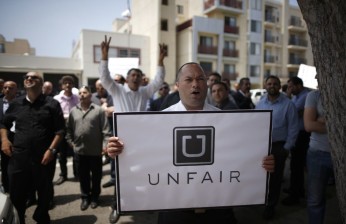By: Quinn Novak
“Uber is evolving the way the world moves. By seamlessly connecting riders to drivers through apps, we make cities more accessible, opening up more possibilities for riders and more business for drivers.”
– UBER[1]
We’ve all been there. You’re out on a Friday night, drinking and having fun with friends. Then, all of a sudden, it’s 2am and you realize you’re exhausted. All you want to do is go home, get under your covers with a family-size box of Cheez-Its, and crash. Lucky for you, there’s an app for that. You pull out your smart phone, carefully type in your home address, and request an Uber driver. Within minutes, you’re picked up in someone’s personal car, with a discreet “U” taped on the window, and driven to your apartment. At the end of the trip, you don’t have to worry about tipping the driver or paying with cash. In fact, you probably checked how much the trip would cost before you requested your Uber, and the fair is automatically transferred when your trip ends.
Simply put, Uber is inexpensive, convenient, fast, and user-friendly. The company is fundamentally changing the way people get around. And, with the service based in sixty countries, with more than eight million users, many people can attest.[2]
However, Uber’s business model has recently been challenged and there is currently a class action lawsuit pending against the service in California.[3] Originally, the action was brought on behalf of three Uber drivers, alleging violations of the California Labor Law and seeking monetary damages.[4] However, a California federal judge extended the class to apply to all Uber drivers in the state.[5] Fortunately for Uber, most of their 160,000 drivers in California cannot participate in the class action lawsuit because they waived their right to class action arbitration through Uber’s updated, 2014 contract.[6]
The remaining drivers who can participate in the suit are upset because they claim that they were misclassified as contractors but are actually employees of the company, entitled to requisite benefits, health insurance, and expense reimbursements.[7] If the appellate court finds that Uber drivers are classified as employees, rather than independent contractors, Uber must reimburse their employees for expenses that are required to do their job, such as gas reimbursements and expenses accrued from general wear and tear of their vehicles, all of which Uber drivers are currently required to pay themselves.[8] Other costs may include Social Security, workers’ compensation, and unemployment insurance.[9]
If Uber is forced to compensate its’ driver as employees, the company’s costs will increase and, more than likely, Uber’s comparatively low cost of transportation will increase.[10] In addition, categorizing drivers as employees could affect the company’s valuation, which is currently above $40 billion, and could affect other similar companies that rely on large networks of individuals to provide rides.[11]
The issue of whether Uber drivers are contractors or employees is not a new topic of interest. In May 2015, “Uber lost a bid to force arbitration in a federal lawsuit brought in San Francisco by its’ drivers” and, earlier in 2015, a San Francisco federal court rejected Uber’s classification of its drivers as independent contractors.[12] Similarly, a Florida state agency recently ruled that Uber drivers are employees, not contractors.[13]
Now the question is left to the California federal court of appeals, after Uber appealed the lower courts’ decision that the case does not have to go through arbitration and may be brought as a class action suit.[14] Uber is insisting that the all disputes be taken to an arbiter and cannot be brought in a class action lawsuit.[15] Uber claims that their drivers go to work for their service for different reasons, are free to turn on or off the application as they choose, and, therefore, do not have enough in common to sue as a class.[16]
The appellate court must decide whether or not the lower court was correct in allowing a class action lawsuit against Uber. In addition, a future question the court must address is whether or not Uber drivers are employees or contractors.
For now, Uber-users can rest easy that no decision has been made and the price of transportation won’t dramatically increase anytime soon due to Uber redesigning its’ business model to reimburse its’ “employees.” So, feel free to continue using the app when you’re out late at night and all you want to do is go home and climb into bed. Uber is still cost efficient… for now.
[1] Home, UBER, https://www.uber.com/about (last visited Sept. 1, 2015).
[2] Our Cities, UBER, https://www.uber.com/cities (last visited Sept. 1, 2015); Craig Smith, By the Numbers 24 Amazing Uber Statistics, DMR: Digital Marketing/Stats/Strategy/Gadgets (Sept. 30, 2015), http://expandedramblings.com/index.php/uber-statistics/.
[3] Laura Sydell, A Suit Against Uber Could Redefine The Sharing Economy, NPR (Sept. 2, 2015, 5:20 AM), http://www.npr.org/2015/09/02/436820824/california-court-grants-uber-drivers-class-action-status.
[4] A.J. Kritkos, A Lawsuit to Break the Gig Economy: Uber drivers claim they are legally employees, but that doesn’t reflect reality, Wall St. J (Sept. 20, 2015, 6:30 PM), http://www.wsj.com/articles/a-lawsuit-to-break-the-gig-economy-1442788712.
[5] Laura Lorenzetti, Everything to Know About the Uber Class Action Lawsuit, Fort. (Sept. 2, 2015, 1:53 PM), http://fortune.com/2015/09/02/uber-lawsuit/.
[6] Id.
[7] Id.
[8] Sydell, supra note 3.
[9] Sarah McBride & Dan Levine, Uber Drivers are Employees, Not Contractors California Labor Commission Rules, Huffington Post: TECH (May 17, 2015, 10:40 AM), http://www.huffingtonpost.com/2015/06/17/uber-drivers-lawsuit_n_7603630.html.
[10] Lorenzetti, supra note 5.
[11] McBride, supra note 9.
[12] Id.
[13] Id.
[14] Laura Northrup, Judge: Uber Contract Forcing Drivers Into Arbitration Contradicts Itself, Consumerist (Sept. 21, 2015), http://consumerist.com/2015/09/21/judge-uber-contract-forcing-drivers-into-arbitration-contradicts-itself/.
[15] Id.
[16] Id.
Photo Source: https://fortunedotcom.files.wordpress.com/2015/06/rtr3vkj9.jpg?quality=80&w=1024
Photo Source: http://www.adweek.com/files/imagecache/node-blog/blogs/uber-safe-hed-2015.png


